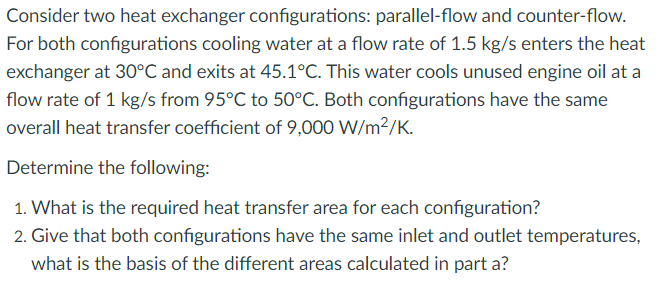Consider two heat exchanger configurations: parallel-flow and counter-flow. For both configurations cooling water at a flow rate of 1.5 kg/s enters the heat exchanger at 30°C and exits at 45.1°C. This water cools unused engine oil at a flow rate of 1 kg/s from 95°C to 50°C. Both configurations have the same overall heat transfer coefficient of 9,000 W/m²/K. Determine the following: 1. What is the required heat transfer area for each configuration? 2. Give that both configurations have the same inlet and outlet temperatures, what is the basis of the different areas calculated in part a?
Consider two heat exchanger configurations: parallel-flow and counter-flow. For both configurations cooling water at a flow rate of 1.5 kg/s enters the heat exchanger at 30°C and exits at 45.1°C. This water cools unused engine oil at a flow rate of 1 kg/s from 95°C to 50°C. Both configurations have the same overall heat transfer coefficient of 9,000 W/m²/K. Determine the following: 1. What is the required heat transfer area for each configuration? 2. Give that both configurations have the same inlet and outlet temperatures, what is the basis of the different areas calculated in part a?
Principles of Heat Transfer (Activate Learning with these NEW titles from Engineering!)
8th Edition
ISBN:9781305387102
Author:Kreith, Frank; Manglik, Raj M.
Publisher:Kreith, Frank; Manglik, Raj M.
Chapter7: Forced Convection Inside Tubes And Ducts
Section: Chapter Questions
Problem 7.46P
Related questions
Concept explainers
Heat Exchangers
Heat exchangers are the types of equipment that are primarily employed to transfer the thermal energy from one fluid to another, provided that one of the fluids should be at a higher thermal energy content than the other fluid.
Heat Exchanger
The heat exchanger is a combination of two words ''Heat'' and ''Exchanger''. It is a mechanical device that is used to exchange heat energy between two fluids.
Question

Transcribed Image Text:Consider two heat exchanger configurations: parallel-flow and counter-flow.
For both configurations cooling water at a flow rate of 1.5 kg/s enters the heat
exchanger at 30°C and exits at 45.1°C. This water cools unused engine oil at a
flow rate of 1 kg/s from 95°C to 50°C. Both configurations have the same
overall heat transfer coefficient of 9,000 W/m2/K.
Determine the following:
1. What is the required heat transfer area for each configuration?
2. Give that both configurations have the same inlet and outlet temperatures,
what is the basis of the different areas calculated in part a?
Expert Solution
This question has been solved!
Explore an expertly crafted, step-by-step solution for a thorough understanding of key concepts.
This is a popular solution!
Trending now
This is a popular solution!
Step by step
Solved in 3 steps with 3 images

Knowledge Booster
Learn more about
Need a deep-dive on the concept behind this application? Look no further. Learn more about this topic, mechanical-engineering and related others by exploring similar questions and additional content below.Recommended textbooks for you

Principles of Heat Transfer (Activate Learning wi…
Mechanical Engineering
ISBN:
9781305387102
Author:
Kreith, Frank; Manglik, Raj M.
Publisher:
Cengage Learning

Principles of Heat Transfer (Activate Learning wi…
Mechanical Engineering
ISBN:
9781305387102
Author:
Kreith, Frank; Manglik, Raj M.
Publisher:
Cengage Learning